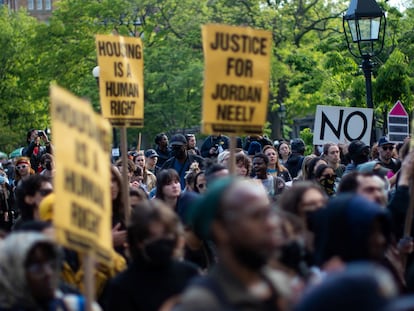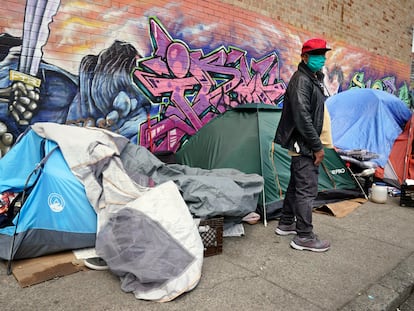Homelessness soars in L.A. despite mayor’s crusade to reduce it
Statistics indicate an increase of 10% among those sleeping rough, for a total of around 75,500 people


Los Angeles has 6,000 more homeless people today than a year ago. The numbers have increased by 9% in the county of Los Angeles, and 10% in the city, according to a recent survey made public by the municipal services on June 30. In total, some 75,500 people are either living on the streets, in shanty towns or inside vehicles. In 2022, there were just over 69,000.
The new figures put even more pressure on the local authorities to ramp up their efforts to tackle one of the city’s most visible problems. When Los Angeles Mayor Karen Bass took office last December, she immediately made the issue one of her priorities. However, despite an investment of over $1 billion, there appears to be little to show.
The problem has been growing in three areas of the city in particular, according to the survey which was conducted over three days last January. One is West Los Angeles, in neighborhoods such as West Hollywood, Venice and Santa Monica. The other is the port city of Long Beach. In each, the survey recorded approximately 2,000 new rough sleepers affected by issues including rising housing prices, mental health problems (a quarter of the homeless population), and substance abuse (a third). South Los Angeles also saw an increase of 1,600 people without a roof over their heads. These figures do not include a further 20,000 already living in shelters thrown up in recent years.
Latinos are the demographic mostly likely to be affected by homelessness, accounting for 43% of rough sleepers. This figure has not, however, increased substantially since 2022. Hispanics are the majority in Los Angeles County, a vast region of 10 million people spread across 88 cities. The African-American community is also particularly vulnerable. Three out of every 10 people living on the streets are Black, despite the fact they account for less than 10% of the population. The survey also reported that more Asians are living on the streets compared to last year, but account for only 2% of homelessness – or approximately 1,200 rough sleepers.
Faced with the results of the survey, Karen Bass has recognized that she is facing a “huge challenge.” She stated that she will continue to work with all levels of government to “address this crisis as the emergency that it is.” The first female mayor in Los Angeles, Bass has the support of the county’s board of supervisors. Supervisor Janice Hahn has called the new figures “disappointing,” but said that 2023 should serve as a watershed in the fight against homelessness, a problem that has plagued several California cities for decades.
Homelessness has been on the rise since 2015, with a brief respite in 2018, when a 4% drop was reported following a $1.2 billion investment in new and affordable housing, the scarcity of which is undoubtedly a major contributary factor. This reprieve was followed by two years of soaring homelessness that snuffed out any optimism regarding the issue. Rough sleeping increased in the county by nearly 26% between 2018 and 2020. The pandemic exacerbated the situation by increasing cases by 4.1% in 2021. Over the course of eight years, the phenomenon has increased 70% in the county and 80% in the city.
The figures prompted Bass to prioritize the issue, championing the cause from the moment she took office in a city with more than 40,000 rough sleepers. On her first day in office, she put her strategy to a vote by the City Council, which approved a proposed investment of around $100 million to move people sleeping on the streets and in tents into shelters run by local authorities or non-governmental organizations. It also launched an emergency declaration to facilitate access to federal and state resources to address the situation. Meanwhile, to encourage the construction of low-cost housing, she declared a moratorium on regulations that served as an obstacle to new construction.
In total, Bass’ proposals represent an investment of nearly $1.3 billion, primarily in construction investment funds. It is an increase of nearly $300 million over her predecessor, fellow Democrat, Eric Garcetti. Now, after six months in office, the mayor has reported that she and her administration have taken around 14,000 people off the streets, with 10,000 going to shelters and approximately 4,300 able to access housing thanks to financing models supported by the authorities. The mayor’s measures need time to take effect, but the problem in this corner of the US continues to grow.
Sign up for our weekly newsletter to get more English-language news coverage from EL PAÍS USA Edition
Tu suscripción se está usando en otro dispositivo
¿Quieres añadir otro usuario a tu suscripción?
Si continúas leyendo en este dispositivo, no se podrá leer en el otro.
FlechaTu suscripción se está usando en otro dispositivo y solo puedes acceder a EL PAÍS desde un dispositivo a la vez.
Si quieres compartir tu cuenta, cambia tu suscripción a la modalidad Premium, así podrás añadir otro usuario. Cada uno accederá con su propia cuenta de email, lo que os permitirá personalizar vuestra experiencia en EL PAÍS.
¿Tienes una suscripción de empresa? Accede aquí para contratar más cuentas.
En el caso de no saber quién está usando tu cuenta, te recomendamos cambiar tu contraseña aquí.
Si decides continuar compartiendo tu cuenta, este mensaje se mostrará en tu dispositivo y en el de la otra persona que está usando tu cuenta de forma indefinida, afectando a tu experiencia de lectura. Puedes consultar aquí los términos y condiciones de la suscripción digital.
More information
Archived In
Últimas noticias
80,000 barrels of Mexican oil sent to Cuba: Havana drawn into the US–Mexico clash
Human rights activists, opposition members, and a minor: Maduro’s other political prisoners
Israel sparks a civil war within the MAGA movement
From digital curfews to blocking apps: How technology experts protect their children online
Most viewed
- Reinhard Genzel, Nobel laureate in physics: ‘One-minute videos will never give you the truth’
- Pablo Escobar’s hippos: A serious environmental problem, 40 years on
- Charles Dubouloz, mountaineering star, retires at 36 with a farewell tour inspired by Walter Bonatti
- Why we lost the habit of sleeping in two segments and how that changed our sense of time
- The Florida Keys tourist paradise is besieged by immigration agents: ‘We’ve never seen anything like this’










































